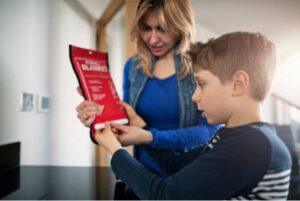
Code Council supports Community Risk Reduction Week efforts to encourage fire prevention and life safety education
![]() By tradition, the fire service has understood the need to build and maintain a rapid and effective emergency response capability. But over the years, individuals, organizations, and countries have concluded that while this approach is essential, it’s not enough. To truly mitigate risk requires a proactive approach and community-organized collaboration. One result is that community risk reduction (CRR) has received worldwide attention through efforts in the United Kingdom, Australia, New Zealand and the United States.
By tradition, the fire service has understood the need to build and maintain a rapid and effective emergency response capability. But over the years, individuals, organizations, and countries have concluded that while this approach is essential, it’s not enough. To truly mitigate risk requires a proactive approach and community-organized collaboration. One result is that community risk reduction (CRR) has received worldwide attention through efforts in the United Kingdom, Australia, New Zealand and the United States.
 Community Risk Reduction encompasses the programs, actions and services used by a community, which prevent or mitigate the loss of life, property and resources associated with life safety, fire and other disasters within a community. It is community-focused and employs the full spectrum of risk-reduction tools, allowing individuals and organizations to identify high-risk neighborhoods, determine hazards, build partnerships, improve safety and form effective strategies with limited resources. It is the all-hazards solution to the all-hazards response that the modern fire service needs to keep pace with a constantly changing social, economic, and political climate.
Community Risk Reduction encompasses the programs, actions and services used by a community, which prevent or mitigate the loss of life, property and resources associated with life safety, fire and other disasters within a community. It is community-focused and employs the full spectrum of risk-reduction tools, allowing individuals and organizations to identify high-risk neighborhoods, determine hazards, build partnerships, improve safety and form effective strategies with limited resources. It is the all-hazards solution to the all-hazards response that the modern fire service needs to keep pace with a constantly changing social, economic, and political climate.
Each year in January, Community Risk Reduction Week — a grassroots initiative of fire safety and fire service professionals across the nation to help reduce the number and impact of emergency events — will work to raise awareness of the importance of CRR in the fire service community and fire services around the country will be promoting the event to educate community members on the importance of mitigating risks for themselves and emergency responders. Sponsored by the nation’s fire service, CRR week will focus not only on fire safety, fire prevention and life safety education but will also encourage citizens to get more involved in their own communities to tackle local issues. The idea of CRR Week originated with individuals from various fire departments across the country and this year, Jan. 18 to Jan. 24, 2021, is designated as CRR Week.
To raise awareness among individuals in the community and the fire service that implementing CRR concepts will make communities and departments safer, the focus of the week will be on the five “E’s” of CRR — education, engineering, enforcement, economic incentive and emergency response. The five E’s are a combination of the original three E’s — education, engineering and enforcement — noted by former U.S. President Harry S. Truman at The President’s Conference on Fire Prevention in 1947. Two additional E’s — economic incentive and emergency response — were added by the National Fire Academy due to their importance in community risk reduction.
Education
Education involves determining the appropriate type and mix of educational messages necessary to inform the public and effect behavioral change. It influences audiences to refrain from risky or unhealthy behavior or take positive action to reduce risk. Effective education:
- Increases knowledge regarding community risks
- Changes attitudes
- Encourages behavioral changes
- Is measurable in evaluations
Engineering
Engineering involves determining whether there are any engineering or technological solutions available to address the identified risk. It includes incorporating new products and technology to modify the environment to prevent or mitigate injuries and deaths. Examples of engineering products/technology:
- Fire sprinklers
- Smoke alarms
- Ground fault circuit interrupters
- Child safety seats
- Bicycle helmets
Enforcement
Enforcement involves identifying whether stronger enforcement is necessary or if newer codes and standards need adoption. It reduces risks by enforcing legislation through inspections and fines for noncompliance. Enforcement activities to consider include:
- Adopting and enforcing fire and life safety codes
- Requiring sprinklers in residential occupancies
- Requiring smoke alarms in residential occupancies
Economic Incentive
Economic Incentives involve identifying whether financial incentives will improve compliance or aid in increasing awareness to community needs. They are typically offered to encourage better choices and changes in behavior. Economic incentives may include any of the following:
- Fines and penalties for violations
- Free smoke alarm and carbon monoxide alarm installations
- Tax credits for installing home fire sprinkler systems
- Reduced-cost child safety seats
- Free bicycle helmets
Emergency Response
Emergency Response involves changes to emergency response protocols to better meet a specific risk or need. It can mitigate the effects of unintentional injuries and save lives. Matters to consider with emergency response include:
- Determining the appropriate mix of equipment
- Training of personnel
- Staffing levels
- Response time of day
Each of the five E’s contribute to the development of comprehensive CRR programs. When combined, the synergistic effect makes them more effective than if utilized individually. Any fire department or community, big or small, rural or metro, paid or volunteer can use CRR Week concepts to identify risks in their communities and start to plan how to reduce those risks. The International Code Council supports the goals and ideas of CRR Week and helps to promote it across the country.
CRR Week FAQs
What is CRR?
Community risk reduction is a data-driven process to identify and prioritize local risks, followed by the integrated and strategic investment of resources (emergency response and prevention) to reduce their occurrence and impact.
What is the goal of CRR?
The goal of CRR is to build healthy, safe and resilient communities. The goal is to reduce the occurrence and impact of emergency events for both members of the community and emergency responders.
What is CRR Week?
CRR Week is a grass-roots effort to promote using the concepts of CRR in any community across the nation.
When is CRR Week?
CRR Week 2020 kicks off on Martin Luther King Day, a National Day of Service, which is Monday, Jan. 18, 2021. It runs through Sunday, Jan. 24.
Who can take part in CRR Week?
Anyone can take part! Any fire department or community, big or small. Rural or metro. Paid or volunteer. Community Risk Reduction is something that applies to any community and is something that any community can undertake.
What is the goal of CRR Week?
The goal is to raise awareness among the fire service about the role of CRR and how any department, no matter what type or where it is located, can use the concepts of CRR to make your community and department safer.
Why should I take part in CRR Week?
CRR Week is a great opportunity to help raise awareness among members of your department about the value of CRR in making your community safer which also translates into firefighter safety as well.
Who is organizing CRR Week?
The idea for CRR Week came up when individuals from various fire departments from across the country were sitting around having coffee This small group is serving as the catalyst to get it going for the first time, but the idea is that this is something that will be acknowledged all across the country.
How do I take part in CRR Week?
CRR Week is a locally driven grass-roots effort. No one knows the risks in your community better than you do, so you can design your own campaign to meet your local needs. While we are suggesting that each day could focus on a different E, it is just that — a suggestion. It also depends upon what resources you have available to you. For example, volunteer departments may choose to use the weekend since that is when their members may be available and people are at home to do home safety visits.
How is it organized?
Each day of the week will have a different focus of one of the five E’s:
-
- Monday — Education. To kick off CRR Week, since it is Martin Luther King Day and a Community Day of Service, we are suggesting that communities use this as a time to go into homes in their communities and install smoke alarms.
- Tuesday — Engineering. This could be an opportunity to have crews go into the community and learn more about the design of buildings or fire protection systems and how they play a role in protecting a building and impact firefighter safety.
- Wednesday — Enforcement. This could be an opportunity for crews to accompany a fire inspector and learn more about how inspections make a community safer and are for the benefit of everyone — the fire department, the community, the property owner.
- Thursday — Economic Incentive. This could be partnering with a local business that is willing to provide a supply of life safety devices (i.e., smoke alarms, car seats, bicycle helmets) to implement in your community.
- Friday — Emergency Response. This could be a day to inform your community about data related to emergency response services in your agency. What are the most common emergencies being mitigated? What is the average response time? Take a look at agency data to determine areas of improvement and discuss with personnel.
- Saturday/Sunday — These are days that volunteer departments can use in promoting any one of the five E’s in their community.
What are some of the specific things I can do for CRR Week?
Encourage fire service personnel to take time to take “CRR Essentials” on IFSTA Resource One. Have every member sign a pledge to actively look for opportunities to incorporate CRR into their service delivery and implement interventions.
Can I do a proclamation for CRR Week?
Yes, you can! Click here and you will find model language for a proclamation that can be tailored for individual jurisdictions which you can submit to your governor, city or state. Proclamations are great ways to get attention on an issue and can also help to get media attention. A CRR Radio podcast is also available to hear from people around the world on CRR ideas that work in their community.
Look for #CRRWeek across social media platforms for efforts, both local and national, by various fire departments. You can also check out the official Twitter and Facebook CRR Week accounts for more information.
For more information on CRR Week and how you can participate, visit the CRR Week website.






